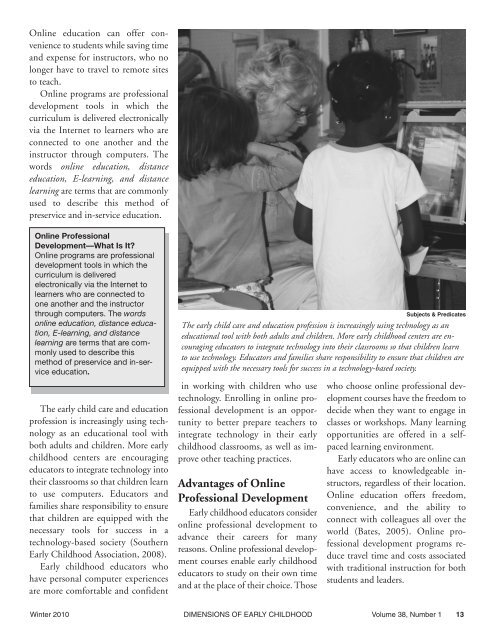90223 Dimensions Winter 10:Layout 1 - Southern Early Childhood ...
90223 Dimensions Winter 10:Layout 1 - Southern Early Childhood ...
90223 Dimensions Winter 10:Layout 1 - Southern Early Childhood ...
Create successful ePaper yourself
Turn your PDF publications into a flip-book with our unique Google optimized e-Paper software.
Online education can offer convenience<br />
to students while saving time<br />
and expense for instructors, who no<br />
longer have to travel to remote sites<br />
to teach.<br />
Online programs are professional<br />
development tools in which the<br />
curriculum is delivered electronically<br />
via the Internet to learners who are<br />
connected to one another and the<br />
instructor through computers. The<br />
words online education, distance<br />
education, E-learning, and distance<br />
learning are terms that are commonly<br />
used to describe this method of<br />
preservice and in-service education.<br />
Online Professional<br />
Development—What Is It?<br />
Online programs are professional<br />
development tools in which the<br />
curriculum is delivered<br />
electronically via the Internet to<br />
learners who are connected to<br />
one another and the instructor<br />
through computers. The words<br />
online education, distance education,<br />
E-learning, and distance<br />
learning are terms that are commonly<br />
used to describe this<br />
method of preservice and in-service<br />
education.<br />
The early child care and education<br />
profession is increasingly using technology<br />
as an educational tool with<br />
both adults and children. More early<br />
childhood centers are encouraging<br />
educators to integrate technology into<br />
their classrooms so that children learn<br />
to use computers. Educators and<br />
families share responsibility to ensure<br />
that children are equipped with the<br />
necessary tools for success in a<br />
technology-based society (<strong>Southern</strong><br />
<strong>Early</strong> <strong>Childhood</strong> Association, 2008).<br />
<strong>Early</strong> childhood educators who<br />
have personal computer experiences<br />
are more comfortable and confident<br />
Subjects & Predicates<br />
The early child care and education profession is increasingly using technology as an<br />
educational tool with both adults and children. More early childhood centers are encouraging<br />
educators to integrate technology into their classrooms so that children learn<br />
to use technology. Educators and families share responsibility to ensure that children are<br />
equipped with the necessary tools for success in a technology-based society.<br />
in working with children who use<br />
technology. Enrolling in online professional<br />
development is an opportunity<br />
to better prepare teachers to<br />
integrate technology in their early<br />
childhood classrooms, as well as improve<br />
other teaching practices.<br />
Advantages of Online<br />
Professional Development<br />
<strong>Early</strong> childhood educators consider<br />
online professional development to<br />
advance their careers for many<br />
reasons. Online professional development<br />
courses enable early childhood<br />
educators to study on their own time<br />
and at the place of their choice. Those<br />
who choose online professional development<br />
courses have the freedom to<br />
decide when they want to engage in<br />
classes or workshops. Many learning<br />
opportunities are offered in a selfpaced<br />
learning environment.<br />
<strong>Early</strong> educators who are online can<br />
have access to knowledgeable instructors,<br />
regardless of their location.<br />
Online education offers freedom,<br />
convenience, and the ability to<br />
connect with colleagues all over the<br />
world (Bates, 2005). Online professional<br />
development programs reduce<br />
travel time and costs associated<br />
with traditional instruction for both<br />
students and leaders.<br />
<strong>Winter</strong> 20<strong>10</strong> DIMENSIONS OF EARLY CHILDHOOD Volume 38, Number 1 13
















